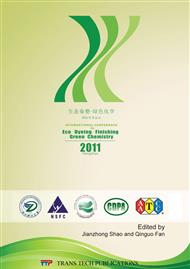[1]
C Cuissinat, P Navard, T Heinze, Swelling and dissolution of cellulose. Part IV: Free floating cotton and wood fibres in ionic liquids, Carbohydr Polym. 72 (2008) 590-596.
DOI: 10.1016/j.carbpol.2007.09.029
Google Scholar
[2]
G Sutmann, Structure formation and dynamics of water in strong external electric fields, J Electroanal Chem. 450-2 (1999) 289-302.
DOI: 10.1016/s0022-0728(97)00649-9
Google Scholar
[3]
Y Okuno, M Minagawa, H Matsumoto, et al, Simulation study on the influence of an electric field on water evaporation, J Mol Struct: THEOCHEM. 904-1 (2009) 83-90.
DOI: 10.1016/j.theochem.2009.02.035
Google Scholar
[4]
D H Jung, J H Yang, M S Jhon, The effect of an external electric field on the structure of liquid water using molecular dynamics simulations, Chem Phys. 244-3 (1999) 331-337.
DOI: 10.1016/s0301-0104(99)00119-6
Google Scholar
[5]
V.P. Mitrofanov, N.A. Styazhkina, Influence of surface adsorbed water on the pendulum damping in an external electric field, Phys Lett A. 256-6 (1999) 351-355.
DOI: 10.1016/s0375-9601(99)00244-3
Google Scholar
[6]
C E Dykstra, External electric field effects on the water trimer, Chem Phys Lett. 299-2 (1999) 132-136.
Google Scholar
[7]
D L Scovell, T D Pinkerton, B A Finlayson, et al, The dielectric response of water in high electric fields: equilibrium water thickness and the field distribution, Chem Phys Lett. 294-3 (1998) 255-261.
DOI: 10.1016/s0009-2614(98)00875-6
Google Scholar
[8]
K Hermansson, L Ojamäe, On the role of electric fields for proton transfer in water, Solid State Ionics. 77 (1995) 34-42.
DOI: 10.1016/0167-2738(94)00288-4
Google Scholar
[9]
E Johansson, P Ahlström, K Bolton, Molecular simulation of the effect of ionic impurities and external electric fields on rod-like water clusters in polyethylene, Polymer. 49-24 (2008) 5357-5362.
DOI: 10.1016/j.polymer.2008.09.052
Google Scholar
[10]
S V Shevkunov, A Vegiri, Electric field induced transitions in water clusters, J Mol Struct: THEOCHEM. 593-3 (2002) 19-32.
DOI: 10.1016/s0166-1280(02)00111-2
Google Scholar
[11]
I Danielewicz-Ferchmin, E Banachowicz, A R Ferchmin, Water phases under high electric field and pressure applied simultaneously, J Mol Liq. 135-3 (2007) 75-85.
DOI: 10.1016/j.molliq.2006.10.006
Google Scholar
[12]
D.L. Scovell, T.D. Pinkerton, V. K. Medvedev, et al, Phase transitions in vapor-deposited water under the influence of high surface electric fields, Surf Sci. 457-3 (2000) 365-376.
DOI: 10.1016/s0039-6028(00)00383-6
Google Scholar


